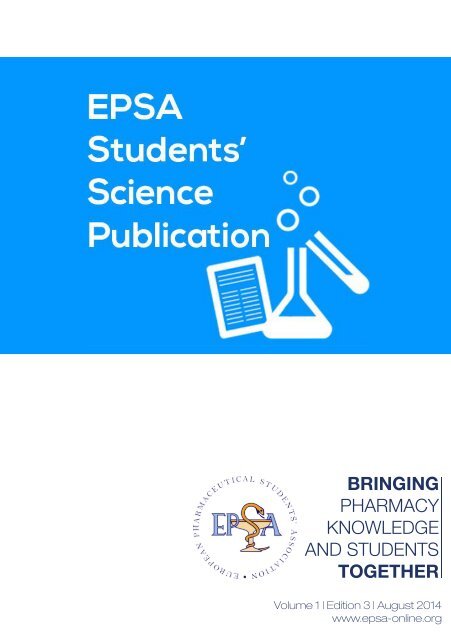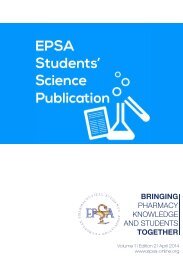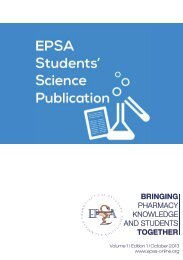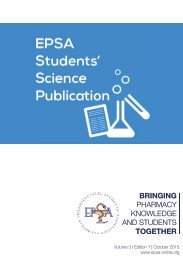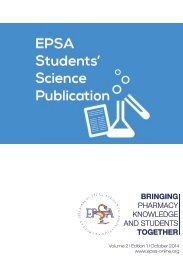essp03
Create successful ePaper yourself
Turn your PDF publications into a flip-book with our unique Google optimized e-Paper software.
Bringing<br />
pharmacy<br />
knowledge<br />
and students<br />
together<br />
Volume 1 | Edition 3 | August 2014<br />
www.epsa-online.org
EPSA Students' Science Publication<br />
INTRODUCTION<br />
Dear friends,<br />
Nearly a year has gone by, and the EPSA Students’ Science Publication (ESSP)<br />
has already been published twice. And now it is time for this year's third and last<br />
edition. The aim of the ESSP has been to give students, who have performed<br />
scientific research during their studies, the possibility to publish their abstracts.<br />
With the professional support of the European Federation for Pharmaceutical<br />
Sciences (EUFEPS), students get the opportunity to develop a new skill by<br />
learning how to write an abstract and how to critically analyse their own results.<br />
EUFEPS is the reviewing body in this project. Professional researchers with<br />
their experience and expertise evaluate each abstract according to the field<br />
they belong to, hence each student receives feedback from someone that is<br />
familiar with the topic.<br />
We are happy to present you 4 very interesting abstracts dealing with various<br />
topics such as: ‘the biochemical analysis of olive leaf extracts as possible<br />
treatment for diabetes’, ‘the impact of modifying the Reformatsky reaction<br />
on yield and purity of a COX-2 ligand’, ‘the design and synthesis of NOD1<br />
inhibitors’ and ‘the biological analysis of the efficiency of new derivatives in<br />
Alzheimer’s Disease’. In addition, as in the previous editions, each student<br />
author will share experiences from the time in which they did their research.<br />
Yours in EPSA,<br />
Rebwar Saleh, Science Coordinator 2013-2014<br />
Janice Geers, Science Coordinator 2014-2015<br />
2
Table of contents<br />
Volume 1 | Edition 3 | August 2014<br />
Activity of olive leaf extracts on Hep G2 cells in hyperglycemic<br />
conditions. M. Amidžić, M. Z. Končić, B. Fumić, R. Petlevski,<br />
P. Marić ..................................................................................... 4<br />
Q&A of the authors ......................................................................... 5<br />
Testing the impact of modified reformatsky reaction on the synthesis<br />
of 3,3-bis-(4-chlorophenyl)-3-hydroxypropionic acid.<br />
K. Iric ......................................................................................... 6<br />
Q&A of the authors ......................................................................... 8<br />
Design And Synthesis Of Indole Scaffold-Based Nod1 Protein<br />
Inhibitors. P. Aleksandra ........................................................... 9<br />
Q&A of the authors ....................................................................... 10<br />
Biological assays of acetylcholinesterase inhibitors. M. Girek,<br />
P. Olszewska, E. Mikiciuk-Olasik, P. Szymański .................... 11<br />
Q&A of the authors ....................................................................... 12<br />
EUFEPS information ..................................................................... 15<br />
3
EPSA Students' Science Publication<br />
ACTIVITY OF OLIVE LEAF EXTRACTS ON HEP G2<br />
CELLS IN HYPERGLYCEMIC CONDITIONS<br />
Mirjana Amidžić, Marijana Zovko Končić, Barbara Fumić, Roberta Petlevski, Patricia Marić<br />
Faculty of Pharmacy and Biochemistry, University of Zagreb, Zagreb, Croatia<br />
Oxidative stress is one of the key mechanisms in the development and<br />
progression of impaired glucose tolerance and insulin resistance. Oxidative<br />
stress has deleterious effects on many organs and tissues, hepatic cells being<br />
one of the main targets. In Mediterranean countries, olive leaves are used as a<br />
traditional medicine for diabetes. It is a rich source of natural antioxidants with<br />
many positive effects on human organisms. Among them, the most prominent<br />
one is the iridoid glycoside - oleuropein. Therefore, the effects of the olive leaf<br />
extracts were investigated on the levels of extracellular lactate dehydrogenase<br />
(LDH), intracellular glutathione (GSH) as well as glutathione S-transferase (GST),<br />
and α-amylase inhibitory activity in Hep G2 cells in hyperglycemic conditions.<br />
In order to investigate potential benefits of olive leaf consumption in diabetes,<br />
its antioxidant activity was assessed using 2,2-diphenyl-1-picrylhydrazyl<br />
(DPPH) free radical scavenging activity, chelating ability and antioxidant activity<br />
using β-carotene-linoleate assay. The extracts were prepared using ultrasonic<br />
extraction, using ethanol/water in varying ratios at several temperatures.<br />
The total content of phenols, flavonoids and phenolic acids was determined<br />
spectrophotometrically, and the content of oleuropein by using a combination<br />
of Thin Layer Chromatography (TLC) and video densitometry. Obtained results<br />
were used for designing experiments for extracts preparation in which content<br />
of polyphenols, flavonoids, phenolic acid and oleuropein were maximized<br />
and the half maximal effective concentrations (EC50 values) of the performed<br />
antioxidant assays were minimal. The conditions giving the highest amounts<br />
were OE-25-75* (25°C, 75% ethanol) for antioxidant activity, OE-20-100*<br />
(20°C, 100% ethanol) for polyphenols and OE-60-100* (60°C, 100% ethanol)<br />
for oleuropein.<br />
In addition, all the extracts have demonstrated notable antioxidant activities.<br />
However, neither of the extracts has shown any α-amylase inhibitory activity.<br />
The activity of the extracts in Hep G2 cells was dependant on the method<br />
used for its preparation. The extract from the OE-25-75* conditions showed<br />
membrane protective properties as seen in lower amount of extracellular<br />
LDH, even in comparison to non-hyperglycemic conditions. Finally, all the<br />
investigated extracts were capable of increasing the GST activity in Hep G2<br />
cells. It could be concluded that olive leaf and its extracts could offer benefits<br />
as adjuvant therapy in diabetes.<br />
4
Q&A of the authors<br />
General information about Mirjana Amidžić<br />
Age: 23 years old<br />
City and country: Zagreb, Croatia<br />
E-mail address: mirjana.ami@gmail.com<br />
University: Faculty of Pharmacy and Biochemistry,<br />
University of Zagreb<br />
Volume 1 | Edition 3 | August 2014<br />
Why did you select this topic for your research?<br />
I have been interested in pharmacy since childhood; more<br />
specifically in preventive medicine and natural ways to<br />
stop disease before it becomes a serious issue. Having<br />
always been fascinated by science, I chose to pursue this interest by studying<br />
herbal properties at the Department of Pharmacognosy.<br />
My perception of science has changed over time as my understanding of the<br />
content has increased and subjects that once appeared independent now<br />
belong to one coherent field and interact with another.<br />
How do you feel about having coped with the challenges that research can<br />
bring?<br />
Challenges in research are numerous, but choosing the right topic and having<br />
a basic focus, as well as the right methodology is fundamental. Last, but not<br />
least, the challenge is dealing with data we have collected. Having an excellent<br />
research team is the best way to cope with any research problem.<br />
What personal skills did you develop as a researcher during your research<br />
period?<br />
Above all, adaptability, accuracy and analytical thinking.<br />
Would you like to share anything else with the students in Europe? Any<br />
recommendations?<br />
I would like to encourage students in developing countries to engage themselves<br />
in research. Even though they might not be working with the latest equipment,<br />
it is possible to obtain good results by using “old-fashioned” methods.<br />
5
EPSA Students' Science Publication<br />
TESTING THE IMPACT OF MODIFIED<br />
REFORMATSKY REACTION ON THE SYNTHESIS<br />
OF 3,3-BIS-(4-CHLOROPHENYL)-<br />
-3 HYDROXYPROPIONIC ACID<br />
Department of Pharmaceutical Chemistry, University of Belgrade – Faculty of Pharmacy,<br />
Serbia<br />
The objective of this work was the assessment of the impact of modifying<br />
the Reformatsky reaction on the yield and purity of 3,3-bis-(4-chlorophenyl)-3-<br />
hydroxypropionic acid. This compound has high affinity to the cyclooxygenase<br />
2 (COX-2) active site and it would be benchmarked against ibuprofen.<br />
The binding energy of complex formation between COX-2 and derivatives of<br />
3-hydroxy-3-aryl propionic acid were calculated and compared with ibuprofen-<br />
COX-2 binding energy. The compound with the best profile was synthesized in<br />
two ways. The first one represents the classical Reformatsky reaction:<br />
O<br />
OZnBr<br />
O<br />
Br<br />
O<br />
O<br />
O<br />
+<br />
Cl<br />
Zn/THF<br />
65°C Cl<br />
Cl<br />
O<br />
O<br />
The other represents a modified Reformatsky reaction:<br />
O<br />
O<br />
O<br />
Zn/THF<br />
+<br />
Br<br />
Cl<br />
65°C<br />
OH<br />
O<br />
Br +<br />
O O Cl<br />
Cl<br />
Cl<br />
OZnBr O<br />
O<br />
O<br />
In both cases acid hydrolysis of the products is carried out and products were<br />
extracted:<br />
OZnBr O<br />
OH O<br />
Cl<br />
Cl<br />
O<br />
O H 3O +<br />
Cl<br />
OH<br />
6<br />
Cl<br />
Calculating binding energy in the formed inhibitor-COX-2 complex was<br />
various: binding energy in the ibuprofen-COX-2 complex was -6.90 kcal/mol,<br />
in 3-phenyl-3-(4-chlorophenyl)-3-hydroxypropionic acid-COX-a complex was<br />
-7.45 kcal/mol, in 3,3-bis-(4-chlorophenyl)-3-hydroxypropionic acid-COX-2<br />
complex was -7.73 kcal/mol. The compound with the lowest binding energy,<br />
3-bis-(4-chlorophenyl)-3-hydroxypropionic acid, was synthesised. Purity of the<br />
product after the classical Reformatsky reaction was 44.60% and 95.90% after<br />
modified Reformatsky reaction. The purity was examined by using the HPLC<br />
method with FID detector. The yield after the modified Reformatsky reaction<br />
was 52.74%. The structure of the obtained compound was characterized by<br />
LC/MS, IR and NMR spectroscopy.<br />
Cl
Volume 1 | Edition 3 | August 2014<br />
Based on results of docking studies it was concluded that some derivatives of<br />
3-hydroxy-3-aryl propionic acid have lower binding energy than the ibuprofen<br />
in complex with the COX-2 active site. Based on these findings, these<br />
derivatives could be more potential inhibitors of COX-2 than ibuprofen, and<br />
could exhibit better anti-inflammatory activity. Based on results after synthesis,<br />
it was concluded that the synthetic route to obtain 3,3-bis-(4-chlorophenyl)-<br />
3-hydroxypropionic acid was improved by using the modified Reformatsky<br />
reaction, where the ester, which subsequently will react with the ketone, is<br />
the first to be synthesised. In this way a higher level of purity of the product<br />
is obtained. As anti-inflammatory effects of the synthesised compound are<br />
expected, further studies in vivo will be of high interest.<br />
7
EPSA Students' Science Publication<br />
Q&A of the authors<br />
General information about Katarina Iric<br />
Age: 23<br />
City and country: Belgrade, Serbia<br />
E-mail address: katarina.iric@gmail.com<br />
University: University of Belgrade, Faculty of Pharmacy<br />
Why did you select this topic for your research?<br />
I decided to work on synthesis of non-steroidal antiinflammatory<br />
agents (NSAID), because I found that it is<br />
an interesting topic. We started with a target enzyme, and<br />
in the end, we had a lot of synthesised molecules with characterised structures<br />
and optimised synthetic route.<br />
How do you feel you having coped with the challenges that research can bring?<br />
When I saw unexpected results for the first time, I was really surprised. At first,<br />
I repeated the whole experiment, followed by literature data and I checked my<br />
methodology. I didn't know what to do next because my theory wasn't proved.<br />
Then I changed my hypothesis, modified experiments and that led me to the<br />
new results and new important conclusions.<br />
What personal skills did you develop as a researcher during your research<br />
period?<br />
Critical thinking is definitely the most important one. Experience in the lab<br />
is also important for preparing experiments (especially in pharmaceutical<br />
chemistry), but you can learn it during the practice at Faculty: everyone can<br />
make an experiment – you just have to follow instructions. But, if you have<br />
critical thinking, you will rationally analyse your problems during the research<br />
period, you will try to improve things that are good and minimise things that<br />
are not so good.<br />
Anything else you want to share with the students in Europe? Recommendations?<br />
Every research has periods when everything you do goes wrong, but it doesn't<br />
mean that you should give up on everything. Every result is important, although<br />
some of them are not matching with the expected ones.<br />
8
Volume 1 | Edition 3 | August 2014<br />
9
EPSA Students' Science Publication<br />
DESIGN AND SYNTHESIS OF INDOLE<br />
SCAFFOLD-BASED NOD1 PROTEIN INHIBITORS<br />
Pekošak Aleksandra<br />
University of Ljubljana, Slovenia<br />
A complex system of the immune system offers several targets for rational<br />
design of novel drugs. Our target was the intracellular NOD1 receptor that<br />
detects fragments from peptidoglycan, specifically meso-diaminopimelic acid<br />
and meso-DAP containing fragments. In response to bacterial ligands the<br />
NF-κB pathway is activated, leading to the production of pro-inflammatory<br />
cytokines, chemokines and apoptosis, and also potentially to septic shock,<br />
chronic inflammatory or autoimmune diseases. At this point NOD1 inhibitors,<br />
which could effectively and selectively inhibit the inflammatory response of the<br />
immune system, have an important role.<br />
Based on the knowledge of the structure-activity relationship of known NOD1<br />
inhibitors, new compounds were designed with a 2-aminoindole scaffold using<br />
"scaffold hopping". The indole scaffold is present in a number of biologically<br />
active compounds and is regarded as a "privileged structure" and was therefore<br />
used as a benzimidazole mimetic.<br />
The scaffold replacement proved satisfactory, based on biological tests<br />
measuring the percentage of inhibition of NF-κB activation stimulated with<br />
agonist C12iE-DAP on the Ramos-Blue cells. The most active compound<br />
13, 1-(4-chlorobenzyl)-indoline-2-iminium chloride, inhibited NF-κB activation<br />
even better than the well-known inhibitor Noditinib. A chloro substituent in<br />
position 4 in the aromatic ring (R2) and amino group on the indole (R4), which<br />
could form hydrogen bonds with active site of enzyme, showed an increased<br />
inhibition activity. However, because of the high standard deviation this<br />
compound cannot be regarded as a better inhibitor. In conclusion, although<br />
compound 13 proved cytotoxic at a high concentration, it represents a good<br />
starting point for further optimization.<br />
Cl<br />
N<br />
NH 3 + Cl -<br />
13<br />
Graph: Residual activity NF-κB of NOD1 inhibitors in Ramos-Blue cells<br />
10
Q&A of the authors<br />
General information about Aleksandra Pekošak<br />
Age: 25<br />
City and country: Celje, Slovenia<br />
Email address: aleksandra.pekosak@gmail.com<br />
University: University of Ljubljana, Slovenia<br />
Volume 1 | Edition 3 | August 2014<br />
Why did you select this topic for your research?<br />
During my studies I have always been impressed by<br />
scientists’ achievements – discovery and development<br />
of the most complicated drugs treating various<br />
diseases. During my third year of practical lectures, I found my interest in<br />
medicinal chemistry so I decided to do further research work at the Chair of<br />
Pharmaceutical Chemistry, Faculty of Pharmacy. The immune system and its<br />
complexity has been an unexplored area to me, therefore it was an inspirational<br />
topic for research work because I had to deal with the synthesis of potential<br />
novel immunomodulatory compounds. Therefore I decided to choose this as<br />
my master thesis topic.<br />
How do you feel about having coped with the challenges that research can<br />
bring?<br />
I consider myself a hard-working and fully dedicated person, so I was very<br />
enthusiastic about the research and the results. To be honest, I still remain<br />
optimistic that these compounds will contribute to the pharmaceutical research<br />
in the future.<br />
What personal skills did you develop as a researcher during your research<br />
period?<br />
I learned that novel drugs synthesis requires a lot of time and patience, but on<br />
the other hand I found out that lab work is challenging and also addictive as it<br />
leaves you wanting to find out more. It was definitely a remarkable experience<br />
that contributed to my future career as a researcher.<br />
Would you like to share anything else with the students in Europe? Any<br />
recommendations?<br />
I found topic selection particularly important, especially if you would like to fully<br />
exploit your potential. As you will have to devote quite some time to research,<br />
do not forget to select a topic that you really enjoy working with and as a result<br />
you will contribute to science and also to people's health.<br />
11
EPSA Students' Science Publication<br />
Biological assays of<br />
acetylcholinesterase inhibitors<br />
Małgorzata Girek 1 , Paulina Olszewska 2 , Elżbieta Mikiciuk-Olasik 2 , Paweł Szymański 1<br />
1<br />
Laboratory of Radiopharmacy, Department of Pharmaceutical Chemistry, Drug Analyses<br />
and Radiopharmacy, Medical University, ul. Muszyńskiego 1, 90-151 Lodz, Poland<br />
2<br />
Department of Pharmaceutical Chemistry, Drug Analyses and Radiopharmacy, Medical<br />
University, ul. Muszyńskiego 1, 90-151 Lodz, Poland<br />
Alzheimer’s disease (AD) is one of the most frequent neurodegenerative<br />
disorders and the most common cause of dementia in modern society. The<br />
disease occurs predominantly in people above 65 years old. Cholinergic<br />
system plays the main role in learning process and is progressively damaged<br />
during the illness. Inhibitors of acetylcholinesterase and butyrylcholinesterase<br />
enhance the level of acetylcholine in nerve cells and are the main target in AD.<br />
The aim of the study was to examine the acetylcholinesterase and<br />
butyrylcholinesterase inhibition by the new series of tetrahydroacridine<br />
derivatives. Twenty three compounds were analysed and the three best<br />
inhibitors were examined to define the type of inhibition and their kinetic value.<br />
The Ellman’s test is a common biological assay. With Ellman’s test, it is possible<br />
to measure the concentration of thiols in the sample. First acetylthiocholine was<br />
hydrolysed by enzymes and thereafter the thiocholine reacted with Ellman’s<br />
reagent DTNB (5,5'-dithiobis-(2-nitrobenzoic acid) to produce an ion, which had<br />
a yellow color. The quantity of ion was measured by UV spectrophotometry.<br />
To determine the half maximal inhibitory concentration (IC50) in Ellman’s test<br />
the diverse concentrations of new inhibitors were used. To specify the type of<br />
inhibition diverse concentrations of substrate (acetylthiocholine) were added.<br />
The values of the IC50 were based on absorbance results. Among twenty<br />
three compounds three derivatives of tetrahydroacridine containing three<br />
different groups of substituents – iodobenzoic acid, fluorobenzoic acid and<br />
dimethylaminobenzoic acid (having the lowest IC50 values) were chosen. As the<br />
reference compounds tacrine and rivastigmine were used. The IC50 values of<br />
the tested compounds were significantly lower than the reference compounds.<br />
The derivative of tetrahydroacridine containing dimethylaminobenzoic acid<br />
has been proven to be a competitive type of inhibitor. The derivatives of<br />
tetrahydroacridine with iodobenzoic acid and fluorobenzoic acid moiety are<br />
uncompetitive types of inhibitors.<br />
Biological assays suggest that the new compounds can be a new potential drug<br />
used in treatment of AD. The next step of our research will be concentrated on<br />
cytotoxicity and inhibition of beta-amyloid aggregation by selected compounds.<br />
12
Q&A of the authors<br />
General information about Małgorzata Girek<br />
Age: 24<br />
City and country: Łódź, Poland<br />
E-mail address: m.girek@wp.pl<br />
University: Medical University of Lodz<br />
Volume 1 | Edition 3 | August 2014<br />
Why did you select this topic for your research?<br />
I’ve started in cooperation with the Department<br />
of Pharmaceutical Chemistry, Drug Analyses and<br />
Radiopharmacy at the Medical University of Lodz during<br />
my 3rd year of Pharmaceutical studies. I’ve found out more<br />
about projects they have run and I chose Alzheimer’s disease (AD) because<br />
I considered it as the most interesting. Before pharmacy I wanted to study<br />
neurobiology, therefore being the major reason why I found this topic the<br />
most promising and merging to my concerns. AD is incurable and it offers<br />
many possibilities to work on. My thesis was based on biological assays of<br />
enzymes, which I preferred to the synthesis of new derivatives. I worked both<br />
acetylcholinesterase and butyrylcholinesterase, which behaved diversely. In<br />
vitro experiments may be unpredictable.<br />
How do you feel about having coped with the challenges that research can<br />
bring?<br />
I’ve looked through many publications about AD. Our research are a significant<br />
part of developing novel derivatives which could be used one day in AD<br />
treatment. In June we examined the ability of three selected inhibitors to inhibit<br />
β-amyloid aggregation. All researches are very promising and I’m proud to be<br />
a part of the team who worked on it.<br />
What personal skills did you develop as a researcher during your research<br />
period?<br />
My research period lasted 4 months. I must have become a more precise and<br />
careful person. Each day I prepared solutions and dilutions with a very specific<br />
concentration. I can’t have done any mistakes with even one drop, because<br />
µl is a very small amount and error could lead to repetition of measurement.<br />
Perseverance and patience are the major character traits which helps during<br />
research. I learned a lot from mistakes and nowadays I feel much more<br />
experienced and confident than I was at the beginning of this year.<br />
13
EPSA Students' Science Publication<br />
Would you like to share anything else with the students in Europe? Any<br />
recommendations?<br />
If anybody is interested in research, it’s important to initiate contact with<br />
professors at the university even before thesis as it provides you with<br />
better opportunities to fulfill your aims. Being part of the science team is<br />
an invaluable experience which can open many doors. Checking every<br />
aspect of studying may be significant in determining your professional path.<br />
14
Volume 1 | Edition 3 | August 2014<br />
European Federation for<br />
Pharmaceutical Sciences (EUFEPS)<br />
The European Federation for Pharmaceutical Sciences is a voluntary<br />
association of pharmaceutical scientists, established in 1991 to advance<br />
research in the pharmaceutical sciences in Europe. This can be achieved by<br />
promoting cooperation between national, regional and European societies or<br />
associations which aim at the advancement of pharmaceutical sciences, and by<br />
promoting cooperation between and with other pharmaceutical organisations<br />
and between individual pharmaceutical scientists.<br />
The Mission<br />
EUFEPS exists to help to meet the challenges and seize the opportunities<br />
created by the consolidations occurring both within Europe and globally,<br />
driven on by a combination of rapid advances in science and technology,<br />
economic pressures, and by political will. Within this frame, EUFEPS’s role and<br />
contributions are amply expressed in its mission statement “EUFEPS serves<br />
and advances excellence in the pharmaceutical sciences and innovative drug<br />
research in Europe”. Spearheading a number of initiatives, EUFEPS works with<br />
its membership, throughout the nations of Europe.<br />
European Dimension<br />
EUFEPS is unique being the only pan-European organisation that represents,<br />
under one umbrella, all the pharmaceutical sciences and pharmaceutical<br />
scientists engaged in drug research and development, drug regulation and<br />
drug policy making. The existence of such an umbrella platform facilitates the<br />
highly innovative, integrative and interdisciplinary approaches that are essential<br />
if we, in Europe, are to deliver to our citizens safe, effective, economic and<br />
timely medicines. The ultimate benefits are an improving health, quality of life,<br />
and wealth of our continent.<br />
15
EPSA Students' Science Publication<br />
EUFEPS is recognised by the European Commission, as representing the<br />
integrative pharmaceutical sciences within Europe. EUEFPS is also recognised<br />
by the EMEA as a neutral scientific resource for independent opinions on draft<br />
regulatory guidelines, while EUFEPS works with other European organisations,<br />
such as EFPIA, to help identify and promote training to meet industrial<br />
needs. EUFEPS has the ambition to provide a forum for policy development<br />
in the pharmaceutical sciences, particularly in relations to the discovery and<br />
development of new drugs and their introduction into the market, but also as<br />
to medicines usage. This includes policies on and leadership development as<br />
to: research, education & training, profiling and regulatory affairs.<br />
In addition, EUFEPS plays an active and influential role also in the global arena.<br />
It is recognised by the USA FDA and it works actively with its sister organisation<br />
AAPS to develop co-sponsored meetings and workshops that run alternatively<br />
in Europe and the USA, and is developing links with Asian scientists. Through<br />
involvement with its Board of Pharmaceutical Sciences, EUFEPS is also<br />
working with FIP to advance the pharmaceutical sciences globally.<br />
16
Volume 1 | Edition 3 | August 2014<br />
Upcoming Conferences organised by EUFEPS:<br />
Global Bioequivalence Harmonisation<br />
Initiative<br />
February 2015<br />
For more information see: www.eufeps.org<br />
EuPAT7<br />
May 17-18, 2015, Graz, Austria<br />
organised by EUFEPS<br />
For more information see: www.eupatqbd.org<br />
EUFEPS Annual Meeting 2015<br />
June 2015, Geneva, Switzerland<br />
For more information see www.eufeps.org<br />
6th BBBB Conference on Pharmaceutical<br />
Science: “Strategies to improve the<br />
quality and performance of modern drug<br />
delivery systems”<br />
September 10-12, 2015, Helsinki, Finland<br />
For more information see www.eufeps.org<br />
17
EPSA Students' Science Publication<br />
Announcement – May 2014<br />
7 th pan-European Science Conference<br />
on QbD and PAT Sciences – Inventing<br />
Tomorrow’s Development and Manufacturing<br />
May 18-19 • 2015 • Graz University of Technology • Graz • Austria<br />
The seventh pan-European Science Conference<br />
on QbD and PAT Sciences brings together<br />
pharmaceutical scientists and engineers from<br />
industry, academia and regulatory agencies to<br />
discuss recent developments and future trends in<br />
the field of pharmaceutical product and process<br />
development. The focus of the 7th EuPAT<br />
conference will be on future and emerging trends<br />
in the pharmaceutical sector, including continuous<br />
manufacturing; the development and supply<br />
of personalised medicines and the design and<br />
manufacture of nano-structured, pharmaceutical<br />
products. Regulatory uncertainties, technical<br />
challenges and barriers to adoption which exist<br />
in each of these focus areas will be explored and<br />
debated in detail.<br />
The conference builds on the success of the EuPAT<br />
series established in 2006 and will be organised<br />
by EUFEPS, the Graz University of Technology<br />
and the Research Center for Pharmaceutical<br />
Engineering (RCPE). The main meeting will be<br />
held on May 18-19, 2015, in Graz, Austria, and is<br />
organised back-to-back with a training day centred<br />
on “the Basics of Pharmaceutical Manufacturing<br />
with a focus on Hot-Melt Extrusion - Experiments<br />
18<br />
www.eufeps.org<br />
www.eupatqbd.org<br />
and Modelling”, which is scheduled to commence<br />
on May 17, 2015, at the Graz University of<br />
Technology, Graz, Austria. The attendees of EuPAT<br />
7 are welcome to register for the pre-conference day<br />
and vice versa.<br />
Session topics at EuPAT 7<br />
• PAT and QbD in continuous manufacturing<br />
for drug compounds and products<br />
• Development and production of nanostructured<br />
drug products<br />
• Manufacture and supply of personalised<br />
medicines<br />
• Sensor – new probes and imaging solutions<br />
for innovative control<br />
Invited Speakers at EuPAT 6<br />
Prof A. Florence, Strathclyde, Glasgow UK<br />
Prof B. L. Trout, MIT, Cambridge MA, USA<br />
Prof R. Duncan, Cardiff UK<br />
Prof G. Storm, Utrecht University, Utrecht NL<br />
Dr S. Stegemann, Capsugel, Bornem BE<br />
Dr A. C. Beal, Chief Patient Offices, Sanofi<br />
Prof A. Zeitler, University of Cambridge,<br />
Cambridge UK
afterword<br />
Volume 1 | Edition 3 | August 2014<br />
This edition was made possible by both Science Coordinator 2013-2014<br />
Rebwar Saleh and Science Coordinator 2014-2015 Janice Geers.<br />
Rebwar: ’This edition was planned to finalise as part of the handover period<br />
between us, the Science Coordinators. I thought it was important that the next<br />
Science Coordinator felt safe and comfortable with the project before handling<br />
it all alone. So by doing this edition together, I hope that Janice will be able to<br />
see all the strong sides, and also the weaker sides of the project so that when<br />
the edition is done, she will know how to improve and further develop the<br />
publication. I am very happy with all her efforts, and I am sure she will bring<br />
this "baby publication" further on. Lastly, this publication would never be as<br />
good as it can be without the help of EUFEPS, who put the quality stamp on<br />
the abstracts. Also, our members who choose to utilise this publication, Thank<br />
you!’<br />
Janice: ‘I am really happy to be part of this edition so early in my mandate.<br />
It was a great opportunity to learn about dealing with deadlines, cooperating<br />
with EUFEPS and guiding the students. I really would like to congratulate the<br />
students for their great effort and very nice result! I would also like to thank<br />
EUFEPS for their dedication to our project.’<br />
19


